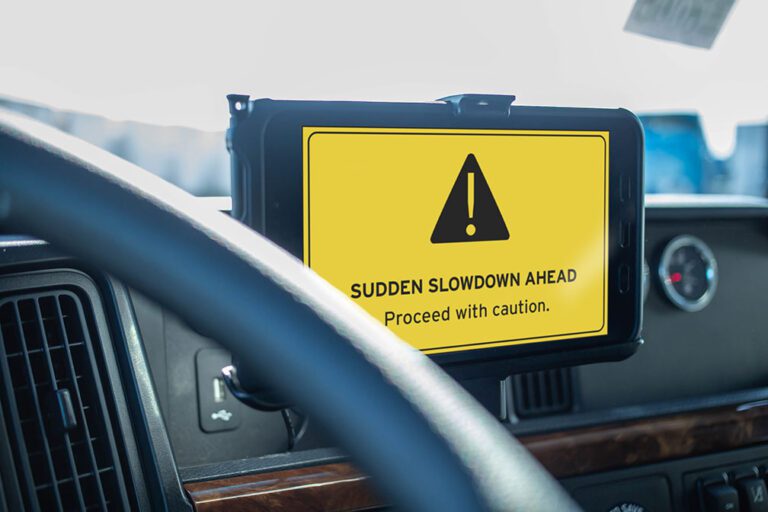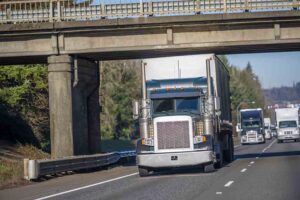PLANO, Texas — Drivewyze has a new service app that delivers essential in-cab safety messages to all commercial truck drivers.
The new service, dubbed Drivewyze Free, provides fleets and drivers with safety alerts and advisories in advance of any and all risky areas on the roadway ahead, according to a news release.
The alerts and advisories are sent to telematics electronic devices.
Drivewyze officials say they created the service app to provide truckers across North American freight corridors with heads-up warnings for high-rollover risk areas, low bridges, mountain alerts (steep grade ahead; chain-up/brake check stations and runaway ramps) and rest area information.
The app also provides real-time message sets that can include warnings for sudden and unexpected slowdowns, virtual safety signs and public emergency broadcasts.
“This is a monumental day for our company, our safety partners, and the industry,” said Brian Heath, CEO of Drivewyze. “In collaboration with our telematics and transportation agency partners, we are excited to be giving this essential safety service to the trucking industry at no cost. There are no strings attached. We’re a safety-driven company joined by like-minded agencies and telematics partners to leverage vehicle-to-infrastructure networks to improve highway safety for everyone. We know many of our Essential Alerts and Advisories modify behavior – drivers slow down and apply less hard braking. It makes them safer behind the wheel. We’re hoping all fleets will utilize this free offering to give their drivers technology that can truly make a difference to their safety.”
According to the press release, with Drivewyze Free, users also have “access to agency-sponsored real-time traffic slowdowns and other safety alerts generated in partnership with select state transportation and enforcement agencies through the Drivewyze Smart Roadways highway safety program for connected trucks.”
Participating state departments of transportation are:
- New Jersey
- New York
- North Carolina
- Georgia
- Delaware
- Connecticut
- Ohio
- Texas
- Arkansas
- Virginia
In addition to the DOTs, the Pennsylvania Turnpike is participating, as is the Colorado State Police and Wyoming Highway Patrol.
Drivewyze says it also wants to partner with additional state transportation and enforcement agencies.
According to Heath, studies have shown that essential safety alerts and advisories do foster safer roadways.
“Unsafe driving behavior is a leading cause of truck crashes,” he said. “Messaging delivered in the vehicle, where and when drivers need it most, shows the power of connected truck technology to positively affect driving behavior. For instance, when approaching a high-rollover area, we have data that shows our alerts have reduced speed by an average of 7.3 mph for those that are going more than 5 mph over the posted speed limit. That’s an impactful difference and an example of the power of in-cab messaging to improve driver behavior and highway safety.”
A National Highway Traffic Safety Administration (NHTSA) study shows that interstate crashes represent nearly 30% of all collisions. Many of those are secondary incidents where a tractor-trailer or car rear-ended another vehicle that was involved in the first crash. The NHTSA study also shows that 46 percent of secondary crashes occur over an hour after the first.
“Advance notice for routes experiencing sudden or unexpected traffic slowdowns give truck drivers time to prepare,” Heath said. “In North Carolina, where we partnered with the North Carolina DOT, studies found that 70% of drivers that received an alert slowed down ahead of an incident. And the slowdown was significant — on average by 11 mph compared to 2 mph in a control group.”
Born and raised in Little Rock, AR, Erica N. Guy decided to stay in her hometown to begin her professional career in journalism. Since obtaining her bachelor’s degree from UAPB, Erica has professionally written for several publications about several topics ranging from lifestyle, tech, culture, and entertainment, just to name a few. Continuing her love for her hometown, she joined our team in June 2023, where she is currently a staff writer. Her career goals include continuing storytelling through her writing by being the best professional writer she can be. In her spare time, Erica enjoys trying new foods, cozying up with a good book, spending time with family and friends, and establishing herself as a future businesswoman.















